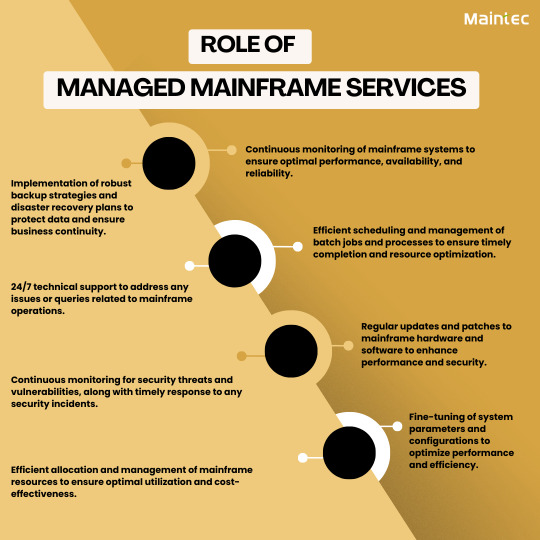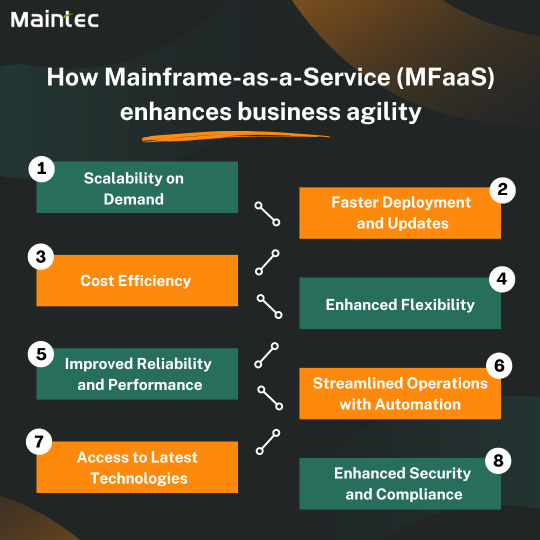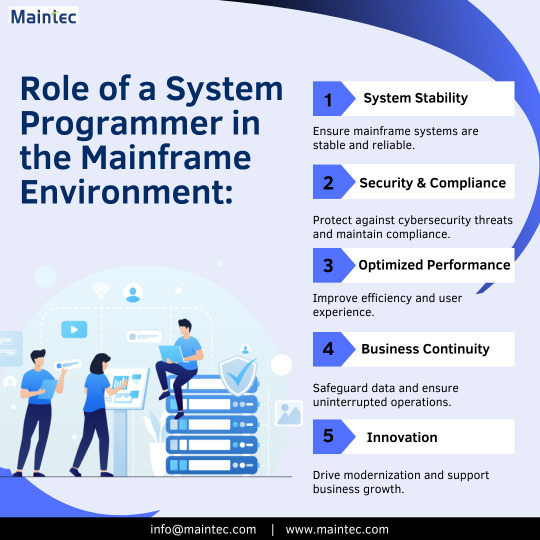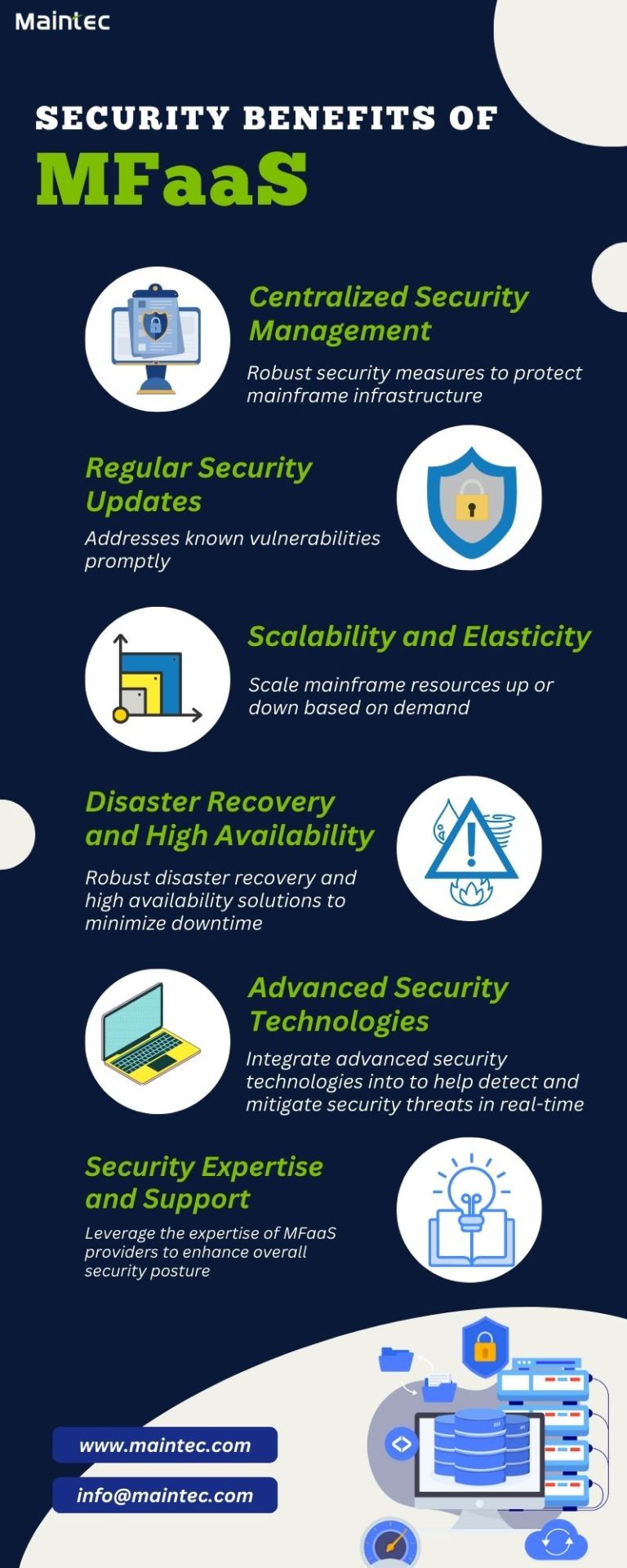Don't wanna be here? Send us removal request.
Text
What is Mainframe Outsourcing? A Comprehensive Introduction
Introduction to Mainframe Outsourcing
As organizations face increasing demands for data processing capabilities, outsourcing these functions to specialized mainframe outsourcing service providers becomes an efficient solution. By doing so, businesses gain access to cutting-edge technology and expertise without investing heavily in in-house resources.
Mainframe outsourcing services help companies stay ahead of technological advancements, improve their operational flexibility, and ensure business continuity. The growing importance of maintaining and upgrading mainframe systems in the current IT ecosystem makes outsourcing a strategic necessity.
The Evolution of Mainframe Outsourcing
Mainframes have been a critical part of enterprise IT for over half a century. Initially, these large systems were the foundation for handling massive data volumes, transactions, and critical operations. However, maintaining and upgrading these systems in-house became increasingly costly and complex as technology progressed. This led to the emergence of mainframe outsourcing services to simplify management and minimize operational overhead.
The rise of outsourcing during the late 20th century aligned with growing global IT demands and development of more agile business environments. IT service providers specializing in mainframe operations began offering comprehensive outsourcing models that included everything from system monitoring to software updates and disaster recovery solutions.
Core Components of Mainframe Outsourcing
Mainframe Managed Services: Day-to-Day Operations One of the primary offerings of mainframe outsourcing service providers is the management of day-to-day operations, which includes monitoring performance, resolving issues, and maintaining system integrity. Outsourcing partners ensure that systems run smoothly, preventing downtime and ensuring that enterprise data is handled efficiently and securely.
Disaster Recovery and Business Continuity Disaster recovery is a cornerstone of mainframe outsourcing. Providers implement robust recovery protocols to ensure that business operations can quickly resume after unexpected disruptions. By outsourcing this function, businesses minimize risk, ensuring continuous operations without needing to build and maintain complex in-house infrastructure.
Application Modernization and Support Legacy applications often need updating to meet the demands of modern environments. Mainframe outsourcing goes beyond basic maintenance, with providers offering application modernization services that enhance functionality and enable integration with newer technologies. These services ensure that businesses stay competitive by leveraging the latest in software and hardware innovations.
Key Drivers Behind Mainframe Outsourcing Adoption
Cost Optimization
One of the main drivers for businesses to turn to mainframe outsourcing services is the potential for cost reduction. Maintaining an in-house mainframe operation demands significant investments in hardware, software, and skilled personnel. By outsourcing, organizations can shift these expenses from fixed to variable costs, freeing up capital to invest in other critical areas.
Access to Specialized Expertise
Mainframes require specific skills to maintain and optimize. With the decreasing pool of mainframe talent, many organizations turn to mainframe outsourcing service providers to access specialized knowledge. These providers employ experts who stay up-to-date with industry developments, ensuring that businesses benefit from the latest innovations in mainframe technology.
Focus on Core Business Objectives
By outsourcing mainframe operations, organizations can offload the complexities of managing legacy systems. This allows businesses to focus on their core activities, such as customer engagement, innovation, and expanding market share, rather than getting bogged down by IT challenges.
Advantages of Mainframe Outsourcing
Enhanced Scalability and Flexibility
Outsourcing offers the flexibility to scale resources according to business needs. Providers offer services that can easily be adjusted as demand fluctuates, ensuring businesses aren’t constrained by rigid infrastructure or resources. This agility allows companies to respond to market changes swiftly and effectively.
Reduced Operational Risks
Mainframe outsourcing reduces operational risks by partnering with experienced providers who apply industry best practices. By leveraging external expertise, businesses can mitigate potential risks related to system failures, downtime, and security vulnerabilities, ensuring higher levels of reliability and uptime.
Improved Compliance and Security
Compliance and security are paramount for organizations handling sensitive data. Mainframe outsourcing service providers are well-versed in industry regulations, offering businesses the peace of mind that their mainframe operations comply with necessary standards. Outsourced providers employ rigorous security protocols to safeguard data, minimizing the risk of breaches or data loss.
Mainframe outsourcing offers a powerful strategy for modern organizations, enabling them to remain agile, secure, and efficient. As technology evolves, businesses can rely on mainframe outsourcing services to navigate the complexities of digital transformation and ensure long-term success.
#mainframe#mainframe services#mainframe outsourcing#mainframe outsourcing services#mainframe outsourcing service providers
0 notes
Text

Is Your Mainframe Aging? 🖥️🔄
Upgrade for efficiency, security, and seamless support with Mainframe Managed Services.
#ibmmainframe#mainframeservices#managedservices#mainframe as a service#mainframemanagedservices#mainframe systems
0 notes
Text

The role of Managed Mainframe Services includes continuous monitoring for optimal performance, availability, and security; efficient scheduling and management of batch jobs; implementation of robust backup and disaster recovery strategies; regular updates and patches to hardware and software; 24/7 technical support; fine-tuning system configurations; and efficient resource management for cost-effectiveness.
0 notes
Text

Discover how Managed Mainframe Services enhance operational efficiency with proactive monitoring, automation, and expert support. Read more- https://www.maintec.com/how-managed-mainframe-services-drive-operational-efficiency/
0 notes
Text

Key performance indicators (KPIs) crucial for monitoring mainframe managed services. It emphasizes the importance of tracking system availability, response time, throughput, CPU utilization, mean time to repair (MTTR), mean time between failures (MTBF), error rate, capacity utilization, cost per transaction, and compliance and security metrics.
#mainframe services#mainframe as a service#mainframe managed services#mainframe managed services provider#mainframe managed services in usa
0 notes
Text
What is z/OS in Mainframe?
Originally designed for large-scale computations, Mainframes now meet modern enterprise demands. From early models to today’s sophisticated systems, mainframes showcase continuous innovation.
At the heart of modern mainframe computing is z/OS, IBM’s premier operating system for Z series mainframes. z/OS provides a reliable, secure, and scalable platform for mission-critical applications, supporting diverse workloads from batch processing to online transaction processing (OLTP).
Core Features of z/OS
High Availability and Scalability : z/OS is renowned for its high availability, designed to minimize downtime and ensure continuous operation during hardware failures or system upgrades. Its scalability allows organizations to handle increasing workloads without compromising performance.
Advanced Security Mechanisms : Security is paramount in today’s digital landscape, and z/OS excels here. It offers advanced encryption, multi-level security policies, and rigorous access controls, making it a preferred choice for industries like finance, healthcare, and government where data integrity and confidentiality are essential.
Workload Management : Efficient workload management is vital for optimal system performance. z/OS’s Workload Manager (WLM) dynamically allocates resources based on workload priorities, ensuring responsive and efficient operations across all applications.
Technical Architecture of z/OS
System Components and Structure: The architecture of z/OS includes numerous components working in harmony for exceptional performance. Key components like the Job Entry Subsystem (JES), Resource Management Facility (RMF), and System Management Facility (SMF) are crucial to its functionality.
Virtualization and Resource Management: Virtualization is central to z/OS, allowing multiple logical partitions (LPARs) to run on a single physical mainframe. The z/OS hypervisor, PR/SM (Processor Resource/System Manager), ensures efficient resource utilization and workload isolation.
Subsystems and Middleware Integration: z/OS supports subsystems and middleware, including CICS (Customer Information Control System), IMS (Information Management System), and DB2. These tools are essential for transaction processing, database management, and application integration, enhancing the platform’s versatility.
The Future of z/OS
Innovations and Technological Advancements : The future of z/OS is promising, with continuous innovations. IBM is enhancing z/OS with machine learning, artificial intelligence, and advanced analytics, elevating its capabilities to meet modern enterprise demands.
Integration with Modern Technologies : z/OS integrates with contemporary technologies such as cloud computing, blockchain, and the Internet of Things (IoT). These integrations transform z/OS into a versatile platform, supporting a wide array of modern applications and services.
Combining decades of innovation with cutting-edge features, z/OS delivers a powerful and versatile platform. Its role in supporting mission-critical applications across various industries underscores its importance, reaffirming its position as a leader in enterprise computing.
0 notes
Text

By leveraging Mainframe as a Service (MFaaS), organizations can achieve greater flexibility, scalability, and cost efficiency, all while maintaining high performance and security standards. #mfaas
0 notes
Text

Remote Infrastructure Management Services (RIMS) help businesses optimize their IT operations and focus on growth-driven activities by reducing costs, ensuring continuous support, providing access to expertise, and enabling scalability.
0 notes
Text
Mainframe-as-a-Service – The Keystone for Bridging Traditional Computing and Modern Solutions
The integration of traditional computing systems with modern IT solutions is not merely a strategic advantage but a necessity in the evolving digital age. Mainframe-as-a-Service (MFaaS) emerges as a critical solution, enabling businesses to preserve the robust capabilities of legacy mainframe systems while capitalizing on the flexibility and scalability of cloud solutions. This integration is particularly crucial for industries rooted in high-volume transactions and sensitive data management, such as finance, healthcare, and government sectors.
Understanding the Need for Mainframe Modernization
Traditionally, Mainframes are celebrated for their high reliability, superior processing power, and robust security features. These systems are vital in managing enormous volume of transactions critical to daily business operations. However, as the digital landscape continuously evolves, the traditional mainframe setup faces challenges such as high maintenance costs, scarcity of skilled professionals, and difficulties in integrating with new-age technologies. Mainframe modernization thus focuses not on replacing, but on thoroughly reinventing these systems. MFaaS offers a pathway to revitalizing these legacy systems by integrating them with cloud capabilities. This collaboration not only addresses the fundamental limitations of traditional mainframes but also aligns them with modern business needs, driving more significant innovation and agility within enterprises.
How MFaaS Facilitates Integration of Traditional and Modern IT Solutions
Scalability and Flexibility: Traditional mainframes are often seen as inflexible, especially when it comes to scaling operations. MFaaS introduces a scalable model where resources are available on-demand, allowing businesses to manage workloads efficiently without the need for extensive physical infrastructure upgrades.
Cost Management: Transitioning to MFaaS converts large fixed costs into variable costs that are easier to manage. This model provides a pay-as-you-go approach, which is particularly advantageous for businesses looking to optimize expenses while still benefiting from the robustness of mainframe capabilities.
Enhanced Integration Capabilities: One of the significant hurdles with traditional mainframes is their integration with modern applications and data platforms. MFaaS providers typically offer tools and services that facilitate seamless integration with cloud services, APIs, and modern databases, bridging the gap between old and new technology environments.
Security and Compliance: MFaaS doesn’t compromise on the legendary security of mainframes. Instead, it enhances it by leveraging the advanced security protocols of cloud services. Additionally, compliance becomes more manageable as service providers ensure that the systems are up-to-date with the latest regulatory requirements.
Why Should Businesses Invest in MFaaS?
Meeting Modern IT Demands: As businesses face increasing pressure to modernize their IT infrastructures, MFaaS provides a less disruptive and more efficient pathway compared to complete system overhauls. This approach allows organizations to continue leveraging their existing mainframe investments while adopting new technologies that drive business growth.
Business Agility: In today's competitive market, agility is key. MFaaS enables organizations to quickly adapt to market changes or operational demands without the lead times typically associated with traditional mainframe reconfiguration or scaling.
Innovation Through Integration: By facilitating easier integration with emerging technologies like AI, machine learning, and big data analytics, MFaaS opens new avenues for innovation. This capability allows enterprises to unlock valuable insights from their existing data while improving operational efficiency.
Conclusion: Investing in the Future of Integrated IT Solutions
The integration of traditional mainframe systems with modern cloud solutions via MFaaS is not just a temporary trend but a forward-looking investment into the future of business technology. This approach provides enterprises with a strategic advantage by enhancing the strengths of mainframes with the flexibility and scalability of the cloud.
Investing in MFaaS means committing to a technology strategy that balances legacy optimization with modernization. It offers a pragmatic path forward that maximizes return on existing investments while positioning the business for future growth and innovation. By choosing MFaaS, companies are not just maintaining their competitive edge; they are sharpening it, ensuring that they are well-equipped to navigate the complexities of the modern digital economy.
0 notes
Text
Role of a Mainframe System Programmer in the Mainframe Environment:
• System Stability: Ensure mainframe systems are stable and reliable.
• Security & Compliance: Protect against cybersecurity threats and maintain compliance.
• Optimized Performance: Improve efficiency and user experience.
• Business Continuity: Safeguard data and ensure uninterrupted operations.
• Innovation: Drive modernization and support business growth.
By taking on these important responsibilities, system programmers help to ensure that mainframe systems continue to be a reliable and secure platform for businesses.

0 notes
Text
Security Benefits of MFaaS
Know the security benefits of Mainframe-as-a-Services (MFaaS)
Centralized Security Management: Robust security measures to protect mainframe infrastructure
Regular Security Updates: Addresses known vulnerabilities promptly
Scalability and Elasticity: Scale mainframe resources up or down based on demand
Disaster Recovery and High Availability: Robust disaster recovery and high availability solutions to minimize downtime
Advanced Security Technologies: Integrate advanced security technologies to help detect and mitigate security threats in real-time
Security Expertise and Support: Leverage the expertise of MFaaS providers to enhance overall security posture #mainframeasaservices

0 notes
Text
Mainframe as a service
Mainframe as a Service (MFaaS) is a cloud computing model that offers mainframe computing capabilities as a scalable and flexible service. Traditionally, mainframes have been associated with large, on-premises systems, but with MFaaS, organizations can leverage the power of mainframes without the need for heavy investments in hardware and infrastructure.
Key features of MFaaS include:
Scalability: MFaaS allows organizations to scale their mainframe resources up or down based on demand, ensuring optimal performance without overprovisioning.
Cost-efficiency: By shifting mainframe operations to a service-based model, companies can reduce upfront capital expenses and maintenance costs associated with traditional on-premises setups.
Accessibility: With MFaaS, mainframe resources are accessible via the Internet, enabling remote access for authorized users and facilitating collaboration across geographically dispersed teams.
Security and Compliance: Providers of MFaaS typically implement robust security measures and adhere to industry compliance standards, helping organizations ensure the confidentiality, integrity, and availability of their data.
Integration: MFaaS platforms often offer integration capabilities with other cloud services and modern technologies, enabling seamless connectivity with existing IT infrastructure and applications.
0 notes
Text
Benefits of Mainframe Services
Experience unparalleled performance, security, and scalability with Mainframe Services. Team of experts specializes in harnessing the immense power of mainframe computing to propel your business forward.
Benefits of Mainframe Services:
Unmatched Reliability: Trust in a platform with a proven track record of reliability and uptime, ensuring your critical business processes run smoothly without interruption.
Robust Security: Safeguard your sensitive data with industry-leading security measures, including encryption, access controls, and comprehensive auditing capabilities.
Scalability: Easily accommodate growing workloads and evolving business needs with the unmatched scalability of mainframe systems, providing the flexibility to adapt to changing demands.
Cost Efficiency: Maximize your IT investment with efficient resource utilization and optimized workflows, reducing overall operational costs while maximizing performance.
Legacy System Modernization: Transform outdated legacy systems into agile, future-ready solutions with our expertise in mainframe modernization strategies, unlocking new opportunities for innovation and growth.
Partner with a Mainframe service provider to leverage the full potential of mainframe computing and drive your business towards success in the digital age.
0 notes
Text
Mainframe Managed Services
Mainframe managed services offer numerous advantages, particularly in terms of efficiency, cost-effectiveness, security, and scalability. Here are some of the key advantages:
Cost Efficiency: Reduce operational expenses through flexible pricing models.
Expert Support: Access specialized professionals for optimized performance.
Reliability: Proactive monitoring minimizes downtime and ensures continuous operation.
Scalability: Easily adjust resources to meet changing demands.
Security & Compliance: Robust measures safeguard data and ensure regulatory adherence.
Focus on Core Activities: Free up internal resources for strategic initiatives.
24/7 Support: Round-the-clock assistance for uninterrupted operations.
Access to Latest Technologies: Leverage advanced mainframe solutions without heavy investments.
Disaster Recovery: Ensure business continuity and data protection.
Simplified Vendor Management: Single point of contact for streamlined operations.
#mainframe managed services#mainframe services#mainframe as a service#ibm mainframe#managed mainframe services
0 notes
Text
How do IT staffing agencies work?
IT staffing agencies play a crucial role in connecting IT professionals with companies seeking qualified talent. Here's a breakdown of how they operate:
For Companies:
Recruitment: Agencies actively source and screen IT candidates, saving companies time and resources. They leverage their talent pools, networks, and expertise to find the right fit for specific roles and skills.
Reduced Cost and Risk: Agencies can help companies avoid the costs and risks associated with traditional hiring. This includes things like advertising, screening, and onboarding.
Flexibility: Agencies offer various staffing solutions like temporary, contract, temp-to-hire, and permanent placements. This allows companies to scale their workforce up or down quickly based on project needs.
Expertise: Many agencies specialize in specific IT sectors, giving them in-depth knowledge of the market, hiring trends, and salary benchmarks.
For IT Professionals:
Job Opportunities: Agencies provide access to a wider range of IT job openings than candidates might find on their own. They often have exclusive listings and relationships with companies in high demand.
Career Guidance: Agencies offer career coaching and resume writing services to help candidates stand out in the competitive IT market.
Negotiation Support: Agencies can negotiate salary and benefits packages on behalf of candidates, ensuring they receive fair compensation.
Networking: Agencies connect candidates with industry professionals and potential employers, expanding their professional network.
Here's a typical workflow:
The company contacts the agency
Agency searches for candidates
Screening and interviews
Candidate submission
Placement
Overall, IT staffing solutions providers in the US can be a valuable resource for both companies and IT professionals, streamlining the hiring process and providing access to a wider range of opportunities and talent.
#it staffing solutions#it staffing services#it staffing#IT staffing solutions in the us#'#IT staffing solution providers
0 notes
Text
Remote IT Staffing
Maintec has been recognized as the best remote IT staffing agency to hire the most qualified of all candidates from our matchless database, to conform to the expertise, knowledge, and credentials required by clients for their remote staffing requirements globally. With the help of such a flexible workforce, companies can rise to the ever-increasing demands of their business expansions and succeed in them. It also proves to be advantageous to corporate workplaces, as they are made available to talented professionals at reasonable expenses as compared to the salaries they pay to their in-house employees.
#staffingsolutions#remoteitstaffing#remotestaffing#remote it staffing solutions#remote it staffing agency
0 notes
Text
How can mainframe managed services help in filling the IT talent gap?
Managed mainframe services can play a crucial role in filling the IT talent gap in several ways:
Access to Specialized Expertise: Managed service providers often have a team of experts with deep knowledge of mainframe systems. This allows organizations to tap into specialized skills and experience they may not have in-house.
Scalability: Managed services can scale up or down as needed, ensuring that an organization has access to the right level of support without the need to hire and train full-time staff.
Cost Savings: Managed services often provide a cost-effective alternative, allowing organizations to pay for the services they need without the overhead of full-time employees.
24/7 Support: Many managed service providers offer round-the-clock support, which is crucial for mainframes that are often used for critical business operations. This ensures that issues can be addressed promptly, minimizing downtime and disruptions.
Focus on Core Competencies: By outsourcing mainframe management to a specialized provider, organizations can free up their internal IT teams to focus on strategic projects and core competencies rather than getting bogged down in day-to-day mainframe operations.
Risk Mitigation: Managed service providers often have robust disaster recovery and security protocols in place. This can help organizations mitigate the risks associated with mainframe operations, ensuring data integrity and compliance with industry regulations.
Knowledge Transfer: Managed service providers can also facilitate knowledge transfer to the organization's internal IT team. This can help in-house staff develop their skills and become more self-sufficient over time.
Flexibility: Mainframe-managed services can be tailored to the specific needs of the organization. Whether it's routine maintenance, troubleshooting, or capacity planning, these services can be customized to address unique challenges.
Rapid Adoption of Technology: Managed service providers are often at the forefront of technological advancements in the mainframe space. By working with them, organizations can quickly adopt new technologies and best practices without the need for extensive training or hiring efforts.
Compliance and Governance: Managed service providers are typically well-versed in industry-specific regulations and compliance requirements. They can help ensure that mainframe operations adhere to these standards, reducing the risk of non-compliance and associated penalties.
In summary, mainframe managed service providers can help organizations bridge the IT talent gap by providing access to specialized expertise, scalability, cost savings, and a range of other benefits. This allows organizations to effectively manage their mainframe systems while focusing on their core business objectives.
0 notes